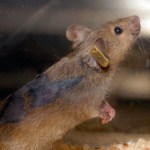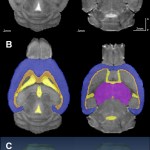I've written on quite a few occasions about a pair of scientists beloved by the antivaccine movement. I'm referring, of course, to Christopher Shaw and Lucija Tomljenovic. Whether it is their publishing dubious "evidence" that HPV vaccines cause premature ovarian failure or even death or demonizing aluminum as a vaccine adjuvant, Shaw and Tomljenovic publish nothing but antivaccine pseudoscience that antivaxers love to cite whenever they dump some turd of a study on the medical literature.
Just last month, they dumped their latest turd of a study, in which they basically tortured mice in the…
mice
Researchers at Stanford University have accomplished what was once considered impossible. They have partially restored vision in blind. Check out this Youtube video to see how they did it
A female mouse that is. You may recall a post from several years ago when we talked about how rats seem to "laugh" when tickled. Back in April 2015 researchers at Duke University presented a video that showed male mice "singing" a tune after either smelling the urine of a female mouse or being in her presence. The sounds were recorded using a microphone designed to capture 35 to 125 kilohertz (kz), which is a much higher frequency than we can hear:
Recent research published in eLife shows that female mice will sing back if interested in the male pursuing her. You can…
Image of common model organisms from European Molecular Biology Laboratory (EMBL).
A recent article posted in the BBC News provided a good explanation of why scientists commonly study these organisms as models for human diseases and conditions. Model organisms are chosen because their physiology is similar to other animals, including humans, in addition to other reasons:
Visit the BBC News to see why researchers most often use flies, fish, mice and worms to understand the mechanisms of disease and health.
Did you know that ~70% of the genes in a…
I discuss the topic of emerging infectious diseases today over at Slate, as part of their Pandemic series.
No one credits heavy drinking with making people smarter - the mind-numbing effects are well documented. Odds are that if you haven't experienced this personally, you've witnessed it in the foolish antics of others. The clear correlation between rapidly diminishing intelligence and rising alcohol consumption is no secret.
But the long-term effects may go deeper than a morning headache or a need to wear sunglasses inside. A new study conducted at Brookhaven National Laboratory reveals that genetic factors can make some individuals more susceptible than others to lasting neurological damage…
The last common ancestor of plants and animals may have lived 1 billion years ago. Plants and animals have occasionally exchanged genes, but for the most part, have countered selective pressures independently. Microbes (bacteria, eukaryotes, and viruses) were omnipresent threats, influencing the direction of multi-cellular evolution. Receptors that detect molecular signatures of infectious organisms mediate awareness of non-self, and are integral to host defense in plants and animals alike. The discoveries leading to identification of these receptors and their ligands followed a similar…
DELETION of a single gene switches the sexual orientation of female mice, causing them to engage in sexual behaviour that is typical of males. Korean researchers found that deleting the appropriately named FucM gene, which encodes an enzyme called fucose mutarotase, causes masculinization of the mouse brain, so that female mice lacking the gene avoid the advances of males and try to mate with other females instead. The findings probably have little relavence to human sexual orientation, however.
FucM is one of a family of enzymes involved in rearranging the atoms in small sugar molecules…
Of all the "alternative" therapies out there, arguably the most studied is the modality known as acupuncture. Perhaps the reason is that, unlike homeopathy, which based on physics, chemistry, and biology alone is so implausible that, for it to "work," huge swaths of well-established physics and chemistry would have to be shown to be not just wrong but extravagantly and outrageously wrong (making homeopathy far more akin to magic than science), or reiki, which, when you come right down to it, is nothing more than faith healing based on Eastern mysticism rather than Christianity, acupuncture…
Sex might be fun but it's not without risks. As your partner exposes themselves to you, they also expose you to whatever bacteria, viruses or parasites they might be carrying. But some animals have a way around that. Ekaterina Litvinova has found that when male mice get a whiff of female odours, their immune systems prepare their airways for attack, increasing their resistance to flu viruses.
Litvinova worked with a group of mice that were exposed to bedding that had previously been soiled by females in the sexually receptive parts of their cycle. She compared them to a second more monastic…
The Not Exactly Pocket Science experiment continues after the vast majority of people who commented liked the pilot post. I'm really enjoying this, for quite unexpected reasons. It's forcing me to flex writing muscles that usually don't get much of a workout. Writing short pieces means being far more economical with language and detail than usual. It means packing in as much information as possible while still keeping things readable. And it means blitz-reading papers and writing quickly without losing any accuracy.
One quick note before the good stuff: last time, a few people suggested that…
Well, not quite. I got an intriguing abstract in my inbox earlier today, to this new paper from BMC Neuroscience:
Here using a new conditioned suppression paradigm, we investigated whether the ability of a foot-shockpaired conditioned stimulus to suppress chocolate-seeking behavior was antagonized by previous exposure to a chronic stressful experience, thus modeling aberrant chocolate seeking in sated mice. Our findings demonstrate that while Control (non-food deprived) animals showed a profound conditioned suppression of chocolate seeking during presentation of conditioned stimulus,…
Today, a new paper published in Nature adds another chapter to the story of FOXP2, a gene with important roles in speech and language. The FOXP2 story is a fascinating tale that I covered in New Scientist last year. It's one of the pieces I'm proudest of so I'm reprinting it here with kind permission from Roger Highfield, and with edits incorporating new discoveries since the time of writing.
The FOXP2 Story (2009 edition)
Imagine an orchestra full of eager musicians which, thanks to an incompetent conductor, produces nothing more than an unrelieved cacophony. You're starting to…
People infected with the bird flu virus - influenza A subtype H5N1 - go through the usual symptoms of fever, aching muscles and cough. The virus is so virulent that 60% of infected humans have died. But according to a study in mice, the infection could also take a more inconspicuous toll on the brain, causing the sorts of damage that could increase the risk of diseases like Parkinson's and Alzheimer's many years after the virus has been cleared.
The link between influenza and Parkinson's disease is hardly old but certainly controversial. Previous studies have found no traces of flu genetic…
Itching is an unpleasant sensation that drives us to scratch reflexively in an effort to remove harmful substances from our body. It's also how I get most of my physical activity for the day. Not being able to scratch an itch is intensely frustrating and many scientists have long described itch as the milder cousin of pain.
But a team of scientists from Washington University's Pain Center (I wonder if they have problems with recruitment) have discovered a group of neurons in the spines of mice that are specific to itch but not to pain. Remove them, and mice hardly ever scratch when they're…
News today has spread about new stem cell research out of China. Two teams used mouse fibroblasts, a kind of cell found in skin connective tissues, to create induced pluripotent skin cells (iPS), which were then used to create living mice.
Their breakthrough research suggests that both cloning full animals from stem cells and the creation of completely pluripotent stem cells from skin cells are both not only possible, but a current reality. The two teams published separately, in Nature and Cell - Stem Cell, both very prestigious journals.
The first task for either study was to create stem…
It's 1964, and a group of Canadian scientists had sailed across the Pacific to Easter Island in order to study the health of the isolated local population. Working below the gaze of the island's famous statues, they collected a variety of soil samples and other biological material, unaware that one of these would yield an unexpected treasure. It contained a bacterium that secreted a new antibiotic, one that proved to be a potent anti-fungal chemical. The compound was named rapamycin after the traditional name of its island source - Rapa Nui.
Skip forward 35 years and rapamycin has made a…
When Walt Disney created Mickey Mouse in 1928, he understood the draw that anthropomorphic mice would have. But even Walt's imagination might have struggled to foresee the events that have just taken place in a German genetics laboratory. There, a group of scientists led by Wolfgang Enard have "humanising" a gene in mice to study its potential relevance for human evolution.
The gene in question is the fascinating FOXP2, which I have written extensively about before, particularly in a feature for New Scientist. FOXP2 was initially identified as the gene behind an inherited disorder that…
Nick Wade in The New York Times reports on new research where they inserted human FOXP2 genes into the mouse genome. Here are some of the findings:
Despite the mammalian body's dependence on having its two FOXP2 genes work just right, Dr. Enard's team found that the human version of FOXP2 seemed to substitute perfectly for the mouse version in all the mouse's tissues except for the brain.
In a region of the brain called the basal ganglia, known in people to be involved in language, the humanized mice grew nerve cells that had a more complex structure and produced less dopamine, a chemical…




